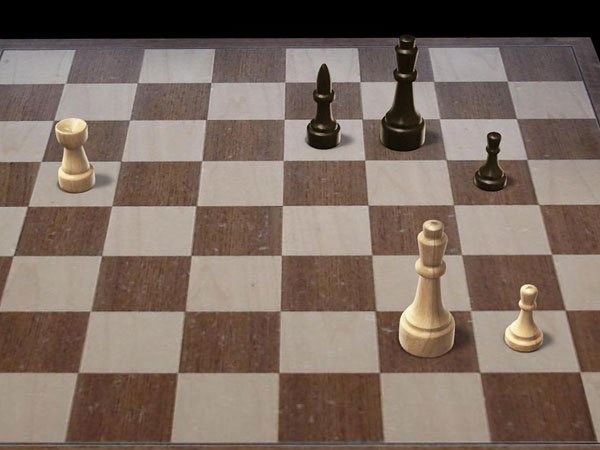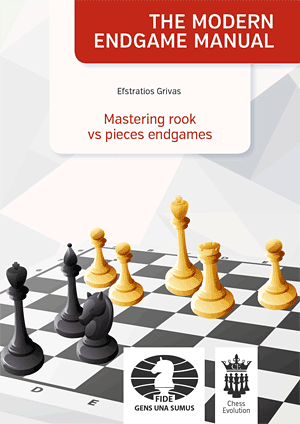


ChessBase 17 - Mega package - Edition 2024
It is the program of choice for anyone who loves the game and wants to know more about it. Start your personal success story with ChessBase and enjoy the game even more.
 In the recent FIDE World Cup a quite familiar ending of rook vs bishop with three pawns for each side on the same side, appeared in the game between two young stars, the Hungarian Richard Rapport and the Chinese Wei Yi.
In the recent FIDE World Cup a quite familiar ending of rook vs bishop with three pawns for each side on the same side, appeared in the game between two young stars, the Hungarian Richard Rapport and the Chinese Wei Yi.
This type of ending is fully analysed in one of my recent books:
The Modern Endgame Manual
Mastering Rook vs Pieces Endgames
by Efstratios Grivas
May 2017, Chess Evolution
344 pages (240 mm by 170 mm)
ISBN: 978-615-80713-2-1
Of course many more pawn structures in this particular ending are analysed, but let’s focus on the above mentioned game. We will start by getting some examples from my book:

[Event "Rook & Pawn vs Bishop & Pawn"] [Site "Athens"] [Date "2011.11.21"] [Round "?"] [White "Example 1"] [Black "The bishop draws"] [Result "1/2-1/2"] [Annotator "Efstratios Grivas"] [SetUp "1"] [FEN "8/1B6/6p1/8/8/4k1P1/3r4/6K1 b - - 0 1"] [PlyCount "12"] [EventDate "2011.11.30"] [EventCountry "GRE"] [SourceTitle "Rook vs Bishop - Advert"] [Source "Grivas CIA"] [SourceDate "2017.09.14"] {White, fully in accordance with the principle of economic defence, has maximized the efficiency of his pieces, keeping the black king away from the pawn. The white king controls f1 and f2, the bishop controls f3, g2, g4, h3 and the pawn covers f4 and h4. In this way, the black king cannot penetrate into White's camp, as the imaginary defence line f1-f2-f3-f4-g4-h4 is strong.} 1... g5 {[%csl Rf1,Rf2,Rf3,Rf4,Rg4,Rh4][%cal Rf1f4,Rf4h4,Rf4f1,Rh4f4]} 2. Bc6 Rf2 3. Bb7 g4 4. Bc6 ({The careless} 4. Bc8 $2 Kf3 $1 5. Bxg4+ Kxg3 {would lose, as the white king is in the wrong corner.}) 4... Rf3 5. Kg2 $1 ({Of course not} 5. Bxf3 $2 Kxf3 6. Kh2 Kf2 {with a won pawn ending.}) 5... Rf6 6. Bb7 Rb6 7. Ba8 1/2-1/2
But now, after the small indroduction, let’s see the game in question. Before we analyse it in detail you may want to try winning the endgame against a chess engine:
And now to the analysis of the game in which the above position appeared:

[Event "FIDE World Cup"] [Site "Tbilisi"] [Date "2017.09.13"] [Round "4.2"] [White "Aronian, Levon"] [Black "Dubov, Daniil"] [Result "1-0"] [ECO "D90"] [WhiteElo "2799"] [BlackElo "2666"] [Annotator "Efstratios Grivas"] [PlyCount "193"] [EventDate "2017.09.13"] [EventCountry "GEO"] [SourceTitle "Rook vs Bishop - Advert"] [Source "Grivas CIA"] [SourceDate "2017.09.14"] 1. d4 Nf6 2. c4 g6 3. Nf3 Bg7 4. Nc3 d5 5. cxd5 Nxd5 6. e4 Nxc3 7. bxc3 c5 8. Be3 O-O 9. Be2 b6 10. Qd2 cxd4 11. cxd4 Bb7 12. e5 Nc6 13. h4 Qd5 14. h5 Rfd8 15. Rc1 Qa5 16. h6 Bf8 17. e6 f6 18. O-O Qxd2 19. Bxd2 Nxd4 20. Nxd4 Rxd4 21. Be3 Rdd8 22. Bb5 Bd5 23. Bd7 g5 24. f4 Bxh6 25. fxg5 Bg7 26. Bd4 fxg5 27. Bxg7 Kxg7 28. Rf7+ Kg6 29. Rxe7 Rf8 30. Re1 Bxa2 31. Bb5 a6 32. Bd3+ Kf6 33. Rxh7 b5 34. Rh6+ Ke7 35. Rh7+ Kf6 36. e7 Rg8 37. Rh6+ Kf7 38. Rh7+ Kf6 39. Be4 Rae8 40. Rh6+ Kf7 41. Bc6 Bc4 42. Bxe8+ Rxe8 43. Rxa6 Rxe7 44. Rxe7+ Kxe7 45. Kf2 Kf7 46. Rb6 Be6 47. Rxb5 Kf6 {[#]A ‘difficult’ but winning position for White. The problem here for Black is that he has to protect extra squares. Compared to the previous example, Black has to protect four ranks instead of three and this proves to be too much. Well, White must be very careful with his g-pawn; for the time being its initial square is best! Note that if in this position the black pawn was on g7, White wins if his pawn is on g2, but drawing if it is on g3 or g4!! Chess is a really hard game...} 48. Kf3 ({As mentioned, the white pawn must stay for the time being on its initial square and the white king must improve. So here} 48. g3 $2 {would lead to a theoretically drawn position:} Bd7 49. Ra5 Be6 50. Ke3 Bd7 51. Kd4 Be6 52. Ra6 Kf5 $1 {and the black king is ready to attack the white pawn! White will move his pawn only when the black king would have been pushed back and will not be able to reach g4.}) 48... Bf5 49. Rc5 Bd3 50. Ke3 Bf5 51. Kd4 Bb1 52. Rc1 Bg6 53. Rc6+ Kg7 { [#]} 54. Ke5 Bb1 55. Ra6 Bc2 56. Rd6 Kf7 57. Rf6+ Kg7 58. Rf2 Bb1 59. Rb2 Bd3 { [#]} 60. Rd2 ({White felt ‘uncertain’ to give the direct blow:} 60. Rb7+ Kg6 61. g4 $1 {(only now!)} Bc2 62. Rb2 Bd3 63. Kd4 Bf1 64. Ke4 Bc4 65. Rb6+ Kg7 66. Kf5 $18 {. But anyway his position remains winning.}) 60... Bb1 61. Ke6 Be4 62. Re2 Bd3 63. Rd2 Be4 64. Ke5 Bb1 65. Rd4 Kf7 66. Ra4 Bc2 67. Ra5 Bb1 68. Rc5 Kg6 69. Rc1 Bd3 70. Rd1 Bc2 71. Rd2 Bb1 72. Ke6 Be4 {[#]} 73. g3 $2 ({ A tragic mistake, which could lose the half-point!} 73. g4 $1 {here is one of the winning moves:} Bb1 74. Rb2 Bd3 75. Rb6 Bc2 76. Ke5+ Kf7 77. Rb7+ Kg6 78. Rb2 $1 Bd3 79. Kd4 Bf1 80. Ke4 {, as already mentioned above. The plan is always to drive the black bishop away from the b1-h7 diagonal, when the white king can land on the crucial f5-square. And that's not too difficult, as the white forces (king, rook and pawn) can take control of all these diagonal squares. What worse is that a series of blunders from both sides begun from here on, connected with the placement of the white g-pawn!}) 73... Bb1 $2 ({ Black didn't got it!} 73... Bf5+ {(or 73... Bf3 and 73...Kh5) draws:} 74. Ke5 Bh3 75. Rc2 Kh5 76. Rc4 Bg4 77. Kf6 Bd7 78. Rc5 Kg4 $1 79. Rxg5+ Kf3 $1 { and we have a theoretical draw! The drawing method consists of the black king on g4/f3 and the black bishop on the h3-c8 diagonal.}) 74. Rb2 $2 (74. g4 { again was the simplest....}) 74... Bd3 $2 (74... Bf5+ 75. Ke5 Bh3 {draws.}) 75. Ke7 $2 (75. g4 $1 {wins.}) 75... Be4 $2 (75... Kf5 {,}) (75... Kh5 {or}) (75... Bf5 {, draws.}) 76. Rb6+ $2 (76. g4 $1 {wins.}) 76... Kg7 $2 (76... Kf5 $1 { draws.}) 77. Rb5 Kg6 {(D) [#]} 78. Rb4 $2 ({Again} 78. g4 {was the only winning move.}) 78... Bc2 $2 (78... Kf5 $1 {draws.}) 79. Kf8 $2 ({It seems that White doesn't know or he didn't find the correct plan...} 79. g4 {again, wins.}) 79... Kf6 $2 {(D) [#]} (79... Kh5 $1 80. Kg7 Bd3 81. Kf6 Ba6 82. Ra4 Bc8 $1 {(the bishop must now be placed in the h3-c8 diagonal, as we have already seen above)} 83. Ra5 Kg4 $1 84. Rxg5+ Kf3 $11 {.}) 80. Kg8 $1 ({ The text, as well as the 'usual'} 80. g4 {, are the only two winning continuations.}) 80... Bd3 ({Or} 80... Kf5 81. g4+ $1 (81. Kg7 $2 Be4 $1 82. Kh6 Bf3 $1 $11) 81... Kf6 82. Kh8 Bd3 83. Rb6+ Ke5 84. Kg7 Kf4 85. Rb4+ $18 {.} ) 81. Rd4 Bc2 {(D) [#]} 82. Rd2 $2 ({Allowing for another one time Black to get the draw. Good was} 82. Kh8 Bb1 83. g4 $18 {.}) 82... Bb1 $2 (82... Be4 $1 {and 83...Kf5 draws.}) 83. Rf2+ Kg6 84. Rb2 $2 (84. g4 $1 {, not allowing ... Bf5 or ...Kh5, was the only winning move.}) 84... Bd3 85. Rb6+ Kf5 86. Rb4 Kf6 $2 (86... Be4 {or}) (86... Be2 {, draws.}) 87. Rd4 Bc2 {(D) [#]} 88. Rd2 $2 ( 88. g4 $1 $18 {.}) 88... Bb1 $2 (88... Be4 $1 $11 {.}) 89. Rf2+ Kg6 {(D) [#]} 90. g4 $1 {Finally!} Be4 91. Rd2 $1 ({Accurate. If} 91. Rb2 $2 Bd5+ 92. Kf8 Be6 93. Rb4 Kf6 94. Ra4 Bd7 $11 {.}) 91... Kf6 92. Rb2 $2 ({Another one blunder!} 92. Re2 $1 {was good:} Bd5+ (92... Bd3 93. Rb2 Be4 94. Rb5 Bc2 95. Rb4 Bd3 96. Rb6+ Ke5 97. Kg7 Kf4 98. Rb4+ $18) 93. Kh7 Be6 94. Rxe6+ $1 Kxe6 95. Kg6 $18 {. }) 92... Bd3 $2 ({And another one favour returning! Good was} 92... Ke5 $1 93. Rf2 Kd4 $1 $11 {.}) 93. Rb6+ Ke5 94. Kg7 Kf4 95. Rb4+ Be4 96. Rxe4+ $1 Kxe4 97. Kg6 (97. Kg6 {And Black resigned due to} Kf4 98. Kh5 Ke5 99. Kxg5 Ke6 100. Kg6 $18 {.}) 1-0
The position is of course winning for White, but I had the feeling that Aronian half-knew the winning idea. He knew that he had to keep his pawn on its initial square and he hesitated to move it even when it was winning! Black didn’t ‘try’ to save himself, showing complete ignorance of the ending and the saving resources, typical of the very young players who know excellent opening theory and are strong in tactics but still have to go a long way on endings…
Chess Endgames 11 - Rook against Bishop
The more reduced the material, the more important it is to correctly assess the potential of your own and the enemy pieces. This is particularly true in endgames with unbalanced material. This DVD begins with a discussion of asymmetrical material balances, including
rook against bishop, rook and knight against two bishops, two rooks against rook and bishop, queen and rook against queen and bishop, rook and knight against bishop and knight, rook against two bishops.
Video running time: 8 hours 26 min.